Physical Address
304 North Cardinal St.
Dorchester Center, MA 02124
Physical Address
304 North Cardinal St.
Dorchester Center, MA 02124
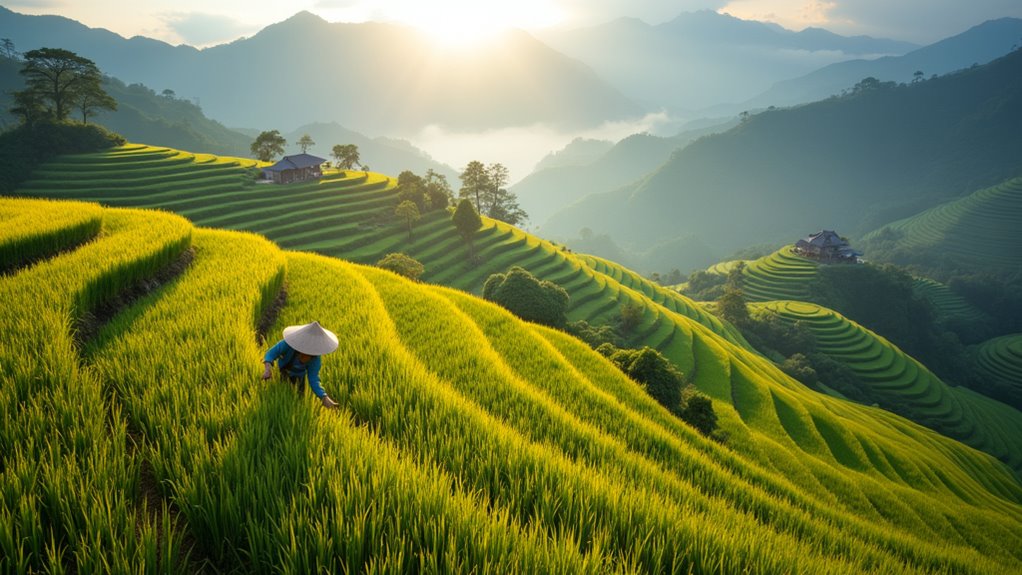
Captivating limestone islands, endless beaches, and world-class cuisine await in Vietnam—but these only scratch the surface of this remarkable destination.
Vietnam enthralls visitors with eight UNESCO sites, including Ha Long Bay’s 1,600 limestone islands and the world’s largest cave, Son Doong. You’ll experience vibrant celebrations like Tet Festival, savor world-class street food from tiny plastic stools, and explore 3,260km of pristine coastline. The unique coffee culture, affordable luxury experiences, and cultural diversity among 54 ethnic groups make this Southeast Asian gem unforgettable. Discover why Vietnam offers experiences rivaling its more famous neighbors.
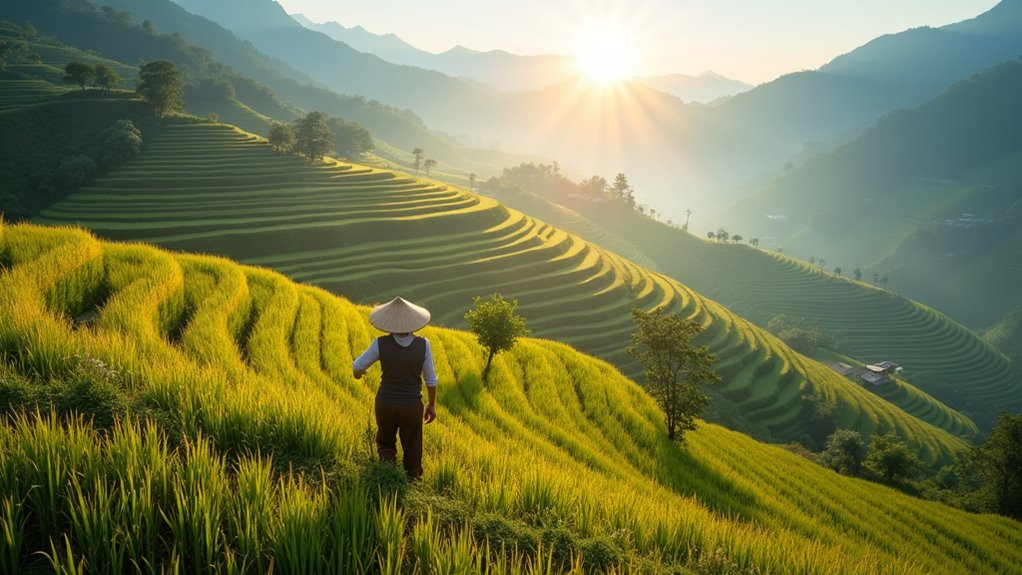
When travelers debate their next destination, Vietnam deserves serious consideration for its remarkable blend of experiences. You’ll encounter UNESCO wonders like Ha Long Bay’s 1,600 limestone karsts and Phong Nha’s massive cave systems alongside vibrant cultural traditions that span millennia.
The country’s tourism infrastructure has rapidly evolved, with Q1 2025 seeing 6 million international arrivals—up 30% year-over-year. You’ll appreciate the recently extended 90-day e-visas and exemptions for 25+ countries that make planning easier. During the Tet holiday season of 2025, Vietnam welcomed a significant surge in tourism with foreign visitors rising 30%, demonstrating the country’s growing appeal on the global stage.
From savoring world-renowned pho in Hanoi to exploring the Mekong Delta’s 40,000 km² of waterways, Vietnam rewards curious travelers. The country offers diverse experiences that satisfy every type of traveler seeking authentic culture. Whether you’re drawn to French colonial architecture, ethnic minority traditions in northern mountains, or tropical beaches, Vietnam delivers unforgettable experiences.
Vietnam’s eight UNESCO World Heritage Sites stand as compelling highlights for any visitor. You’ll be amazed by Halong Bay’s 1,600+ limestone islands and Son Doong, the world’s largest cave, in Phong Nha-Ke Bang National Park.
Experience Vietnam’s opulent cultural heritage at Hue’s imperial monuments, where 150+ historic structures reveal the nation’s royal past. In Hoi An, you’ll wander through perfectly preserved streets of a 15th-century trading port. Like the teardrop island of Sri Lanka, Vietnam offers an impressive concentration of cultural and natural wonders in a relatively compact area.
The Trang An Landscape Complex offers the best of both worlds as Vietnam’s only mixed site, combining stunning karst formations with ancient capital ruins. Vietnam’s commitment to the UNESCO World Heritage Convention has elevated these sites through international conservation efforts.
My Son Sanctuary, Thang Long Citadel, and the Ho Dynasty Citadel showcase different eras of Vietnamese civilization through impressive architecture and historical significance.
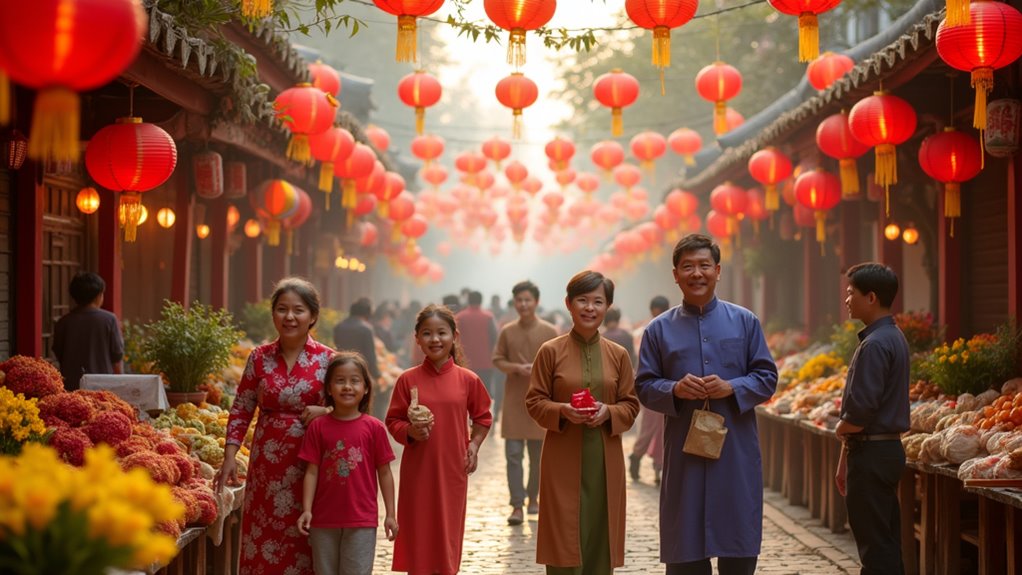
Though celebrated across Asia, Tet Festival stands as Vietnam’s most significant cultural event, transforming the entire country into a vibrant spectacle of tradition and renewal. You’ll witness homes adorned with peach blossoms in the north and apricot flowers in the south, while red banners and calligraphy create a festive atmosphere nationwide.
Join families as they prepare bánh chưng, square rice cakes symbolizing earth and heritage, or explore bustling markets filled with specialty foods and decorations. The celebration showcases Vietnam’s culinary diversity, though it differs greatly from Japanese food culture with its distinct seasonal ingredients and preparation methods. In cities, you can enjoy fireworks and parades around Hanoi’s Hoan Kiem Lake, while rural areas offer authentic pagoda visits and folk traditions. In 2025, the festival will welcome the Year of Snake with celebrations from January 22 to February 12.
Don’t miss receiving lucky money in red envelopes or participating in midnight temple visits for blessings—experiences that reveal Vietnam’s cultural heart during this magical celebration.
Rising dramatically from the emerald waters of the Gulf of Tonkin, Ha Long Bay’s 1,600+ limestone islands create one of the world’s most spectacular seascapes. This UNESCO World Heritage Site has evolved over 500 million years, with towering karsts shaped by wind and water reaching hundreds of meters skyward.
You’ll discover a world where nature and culture intertwine. The name “Ha Long” means “Descending Dragon,” reflecting ancient Vietnamese legends that permeate the region. Despite Vietnam having some dangerous areas, Ha Long Bay remains one of the safest and most awe-inspiring destinations in Asia. The bay offers a rich biodiversity with 163 coral species and approximately 200 fish species inhabiting its pristine waters.
Three ways to experience this geological marvel:
Don’t miss the floating villages where locals maintain traditional fishing and pearl farming lifestyles.
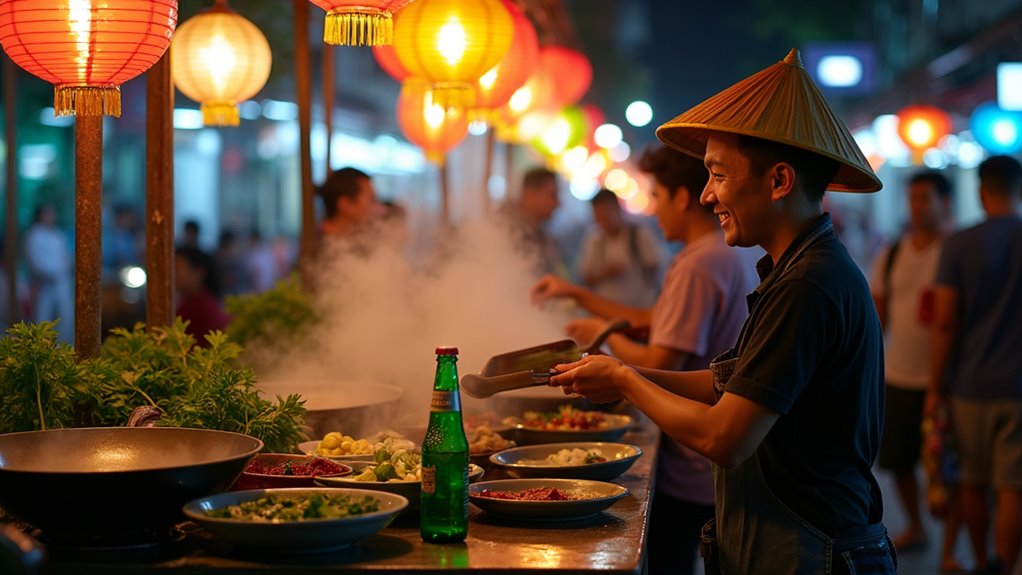
Few culinary experiences rival Vietnam’s street food scene, where vibrant flavors and aromas beckon from every corner. You’ll discover dishes that perfectly balance sweet, salty, sour, and spicy elements, all crafted with impossibly fresh herbs and ingredients.
Vietnam’s street food scene dazzles with sensory delights, masterfully balancing complex flavors through generations of culinary wisdom.
From steaming bowls of pho to crispy banh mi sandwiches, you’re never more than steps away from affordable, delicious meals. The famous Bun Cha dish, enjoyed by Obama and Anthony Bourdain, has become an international sensation representing Vietnam’s culinary excellence. Pull up a tiny plastic stool and join locals for an authentic dining experience that doubles as a cultural exchange.
Each region offers distinct specialties reflecting local traditions passed down through generations. Learning a few basic phrases in Vietnamese will enhance your street food adventures and help you order like a local. Beyond just satisfying hunger, partaking in Vietnam’s street food culture supports small businesses and connects you with the country’s heritage.
It’s an accessible way to understand Vietnamese life while treating your taste buds to unforgettable flavors.
Vietnam offers a rare opportunity to experience luxury without emptying your wallet. You’ll find upscale hotels starting around $20 per night with amenities typically reserved for premium resorts elsewhere in the world.
Your travel budget stretches remarkably far here:
Unlike popular destinations like Thailand and the Philippines, Vietnam remains relatively less crowded while offering similar tropical experiences.
Tech-enhanced luxury touches like smart hotel rooms and seamless digital services further elevate your experience without the premium pricing you’d expect elsewhere.
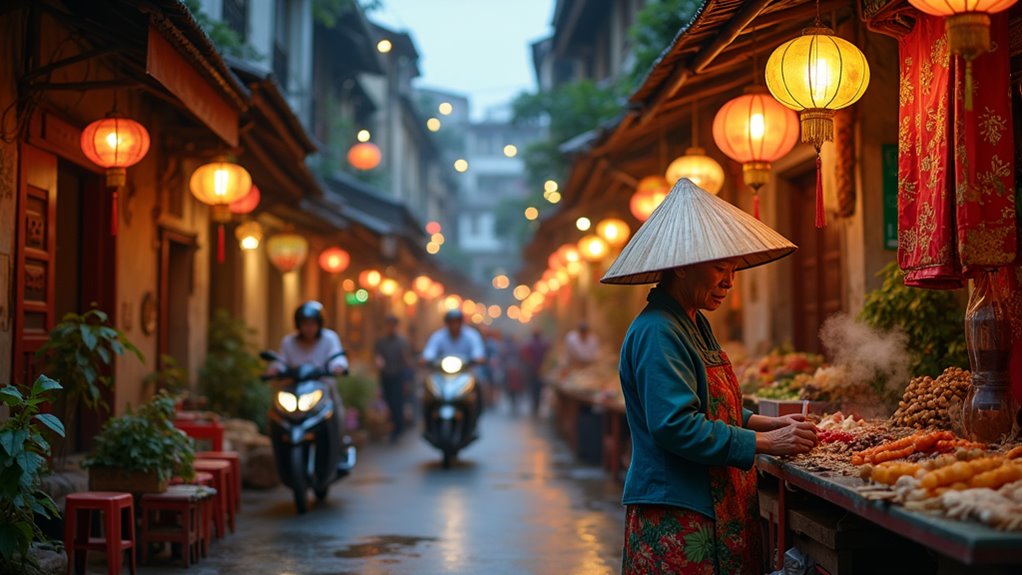
Stepping into Hanoi’s Ancient 36 Streets feels like traveling through a living museum where over 1,000 years of history unfolds with each turn. You’ll discover narrow lanes named after the crafts once exclusively sold there—Hang Bac for silver, Hang Gai for silk, and Hang Dong for bronze metalwork.
The district’s architecture tells Vietnam’s story through its distinctive “tube houses,” French colonial balconies, and hidden temples tucked behind storefronts. As you explore, you’ll encounter artisans practicing ancestral trades alongside modern boutiques. This area originated from the ancient Hanoi 36 pho phuong, reflecting its traditional architecture and remarkable cultural diversity. Many travelers consider this district worth exploring as it represents the authentic soul of Vietnam’s capital city.
Don’t miss the evening atmosphere when lanterns illuminate the streets and food vendors serve authentic pho and bún chả. Whether you’re shopping for handcrafted souvenirs on Hang Ma or discovering Bach Ma Temple, these ancient streets offer Vietnam’s most immersive cultural experience.
Nestled within the rugged Annamite Mountain Range, Phong Nha-Ke Bang National Park houses the world’s most spectacular cave systems, including the colossal Son Doong Cave. This UNESCO World Heritage Site features limestone formations dating back to the Palaeozoic period, making it Asia’s oldest major karst landscape.
When you visit Phong Nha, you’ll discover:
You can join guided tours through these massive caverns, making Phong Nha the perfect destination for adventurers seeking Vietnam’s natural treasures. The Son Doong Expedition, which launched in 2014, has already been fully booked for 2025 with sales now open for 2026 tours. Unlike the cave systems in Southeast Asia countries like Cambodia or Malaysia, Vietnam’s Phong Nha offers unparalleled scale and geological significance.
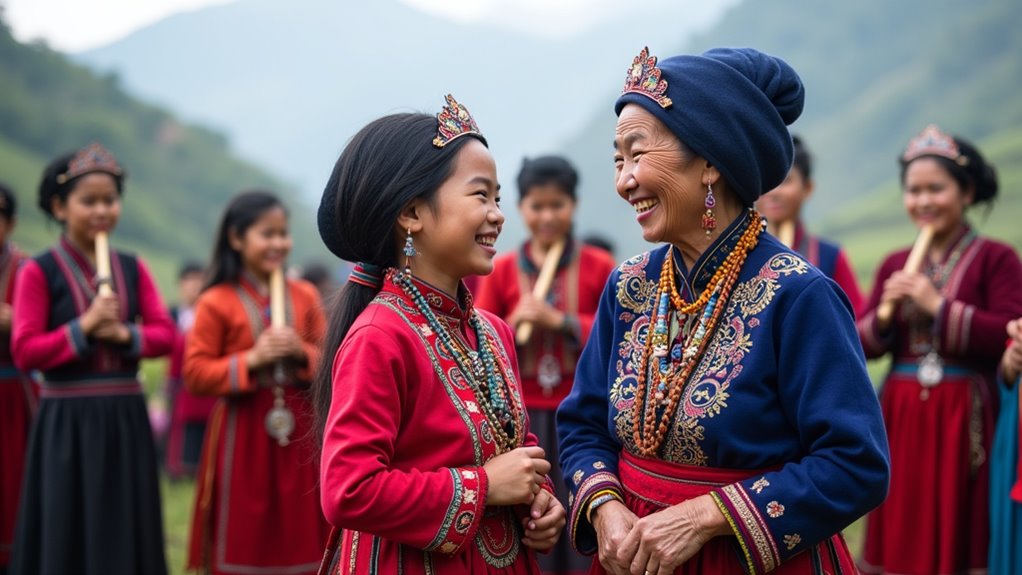
Beyond the natural wonders of Phong Nha’s caves lies another remarkable Vietnamese treasure—the country’s extraordinary cultural mosaic. Vietnam is home to 54 officially recognized ethnic groups, each with unique traditions, languages, and cultural practices.
While the Viet (Kinh) people make up 87% of the population, you’ll discover incredible diversity when you venture into the mountainous regions and remote areas. From the vibrant Lo Lo and Phu La cultures in the Northern Mountains to the Cham and Khmer communities of the Mekong Delta, each region offers distinct cultural experiences. The Central Highlands plateau is particularly fascinating with its indigenous Ba Na ethnic group whose cultural traditions have evolved in harmony with their highland environment.
Don’t miss the annual festivals celebrating ethnic traditions, where you’ll witness colorful ceremonies, traditional music, and authentic cuisine. For travelers deciding between Asian capitals, Vietnam offers a cultural richness that complements city experiences in Tokyo or Seoul. These cultural exchanges provide insights into Vietnam’s national identity that you simply can’t find elsewhere.
Vietnam’s coastline stretches an impressive 3,260 kilometers from the northern border with China to the southwestern edge near Cambodia, offering travelers one of Southeast Asia’s most diverse beach experiences. You’ll find everything from UNESCO-listed Hạ Long Bay‘s limestone islands to the white sands of Da Nang’s My Khe Beach. This extensive shoreline gives Vietnam a favorable coast/area ratio, making coastal attractions easily accessible from most parts of the country. Unlike the Philippines which is an archipelago, Vietnam offers a continuous mainland coastline that makes beach-hopping much more convenient for travelers exploring multiple destinations.
What makes Vietnam’s beaches truly special:
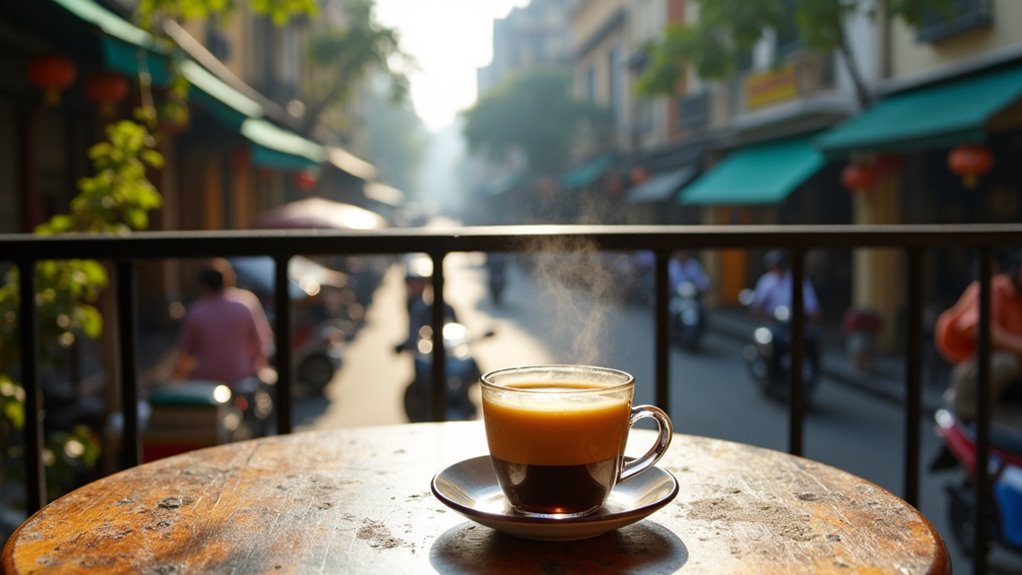
When you step into a Vietnamese café, you’ll immediately notice the distinctive aroma of freshly brewing coffee that has become an essential part of the country’s cultural identity since French missionaries first introduced coffee beans in 1857.
As the world’s second-largest coffee producer, Vietnam offers a coffee experience unlike any other. Approximately 3 million citizens depend on the thriving coffee industry for their livelihoods, demonstrating its economic importance beyond just cultural significance. You’ll watch as your robust brew slowly drips through a traditional metal phin filter, creating a concentrated elixir that’s typically paired with sweetened condensed milk. This combination creates a perfect balance between bitterness and sweetness. While Vietnam’s coffee scene differs greatly from Singapore’s, both countries share a passion for creating iconic food delights that represent their unique cultural heritage.
Coffee in Vietnam isn’t just a beverage—it’s a social ritual. Whether you’re enjoying a morning ca phe sua da (iced coffee with milk) or trying innovative variations like yogurt coffee, you’ll be participating in an authentic cultural tradition worth traveling for.
Vietnam’s magic will stay with you long after you’ve returned home. With 54 distinct ethnic groups preserving centuries-old traditions, you’ll experience cultural diversity few countries can match. Whether you’re sailing through Ha Long Bay or sipping coffee in Hanoi, this Southeast Asian gem offers unforgettable experiences. Don’t just dream about Vietnam’s wonders—make plans to explore them yourself. You won’t regret it.